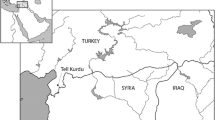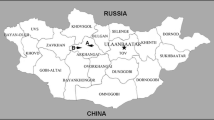Abstract
Archaeomineralogical fieldwork in south-eastern Nigeria combined with metallurgical analyses has now all but confirmed the local provenance of most of the metals used in manufacturing the bronze and copper vessels, ornaments and sculptures which were kept and buried at Igbo-Ukwu about the ninth or tenth century AD. This demonstration may further support the view that the technical skills and artistic inspiration of Igbo-Ukwu were largely locally evolved. Yet the lack of prototypes remains disconcerting. Such a large collection of exquisite bronze artwork and ritual objects is unparalleled for this region at that period; and attempts to explain the circumstances which gave rise to Igbo-Ukwu remain unsatisfactory. It is argued here that, whatever local factors, either religious or secular, may have obtained at that time, there was also an international one. Presumably this region was for a period producing a rare and geographically specific mineral then in high demand in the wider world. The bronzes may be in effect the by-product of that mining and production for export. It is suggested that the principal trade-routes then may not have crossed the Sahara to Muslim North Africa but have run eastward from the Lake Chad region to the Christian countries of the Nile. There may be a hint of this in certain of the bronze forms. Moreover, contact with Egypt, if not indirectly with lands beyond, is demonstrated at Igbo-Ukwu by the vast numbers of imported beads.
Résumé
Un travail archéominéralogique de terrain au sud-est du Nigeria, combiné avec des analyses métallurgiques confirme maintenant la provenance locale des métaux utilisés pour la fabrication des récipients en bronze et en cuivre, des ornements et des sculptures gardés et enterrés à Igbo-Ukwu aux alentours du 9ème et 10ème siècles. Ceci renforce l'hypothèse que les techniques et l'inspiration artistique résultent à Igbo-Ukwu d'une évolution locale. Mais l'absence de prototypes reste déconcertante. Une collection aussi importante d'oeuvres d'art en bronze et objects rituels si raffinés est sans parallèle dans cette région à cette période et les tentatives pour expliquer les circonstances qui conduisirent à l'apparition d'Igbo-Ukwu restent peu satisfaisantes. Cependant, et quels que soient les facteurs locaux, religieux ou profanes qui existaient à cette période, un facteur international a dû jouer. Il est possible que cette région ait pendant une certaine période produit un minéral rare et géographiquement localisé faisant à l'époque l'objet d'une grande demande bien audelà de la région. Les bronzes pourraient donc être les sous-produits d'activités d'extraction et de production destinées à l'exportation. Il est aussi suggéré qu'à cette époque, les principales routes du commerce ne traversaient peut-être pas le Sahara pour joindre l'Afrique du Nord musulmane, mais allaient plutôt en direction de l'Est à partir de la région du Lac Tchad jusqu'aux pays chrétiens du Nil. L'indice pourrait en être la forme de certains bronzes. De plus, des contacts avec l'Egypte, si pas indirectement avec des pays au-delà, sont démontrés par la présence à igbo-Ukwu d'un grand nombre de perles importées.
Similar content being viewed by others
References
Anozie, E. N. 1989. Igbo Ukwu after Thurstan Shaw. Paper presented at conference in honour of Professor Thurstan Shaw, University of Ibadan.
Arkell, A. J. 1936. Darfur Antiquities.S.N.R. 19:301–11.
Arkell, A. J. 1959. A Christian church and monastery at Ain Farah, Darfur.Kush 7:115–19.
Arkell, A. J. 1961.A History of the Sudan to 1821 (2nd ed.). London: Athlone.
Arnett, E. J. 1922.The Rise of the Sokoto Fulani. Kano: The Residency.
Bernus, S. and Gouletquer, F. 1976. Du cuivre au sel.J.S.A. 46:7–68.
Chikwendu, V. E., Craddock, P. T., Farquhar, R. M., Shaw, T. and Umeji, A. C. 1989. Nigerian sources of copper, lead and tin for the Igbo-Ukwu bronzes.Archaeometry 31:27–36.
Chikwendu, V. E. and Umeji, A. C. 1979. Local sources of raw materials for the Nigerian bronze/brass industry: with emphasis on Igbo-Ukwu.W.A.J.A. 9:151–65.
Connah, G. 1987.African Civilizations: precolonial cities and states in tropical Africa, an archaeological perspective. Cambridge: Cambridge University Press.
Craddock, P. T. 1985. Medieval copper alloy production and West African bronze analyses — part I.Archaeometry 27:17–41.
Eyo, E. and Willett, F. 1980.Treasures of Ancient Nigeria. London: Collins and Royal Academy of Arts.
Garlake, P. S. 1977. Excavations on the Woye Asiri family land in Ife.W.A.J.A. 7:57–96.
Garlake, P. S. 1978.The Kingdoms of Africa. Oxford: Elsevier.
Garrard, T. F. 1980.Akan Weights and the Gold Trade. London: Longman.
Herbert, E. W. 1984.Red Gold of Africa: copper in precolonial history and culture. Madison: Wisconsin University Press.
Isichei, E. 1976.A History of the Igbo People. London: Macmillan.
de Kun, N. 1965.The Mineral Resources of Africa. Amsterdam: Elsevier.
Lange, D. 1978. Progrès de l'Islam et changement politique au Kanem du XIe à XIIIe siècle.J.A.H. 19:495–513.
Lange, D. and Berthoud, S. 1977.Al-Qasaba et d'autres villes de la route centrale du Sahara.Paideuma 23:19–40.
Law, R. 1980.The Horse in West African History. Oxford: Oxford University Press.
Lebeuf, J.-P. 1962.Archéologie tchadienne: les Sao du Cameroun et du Tchad. Paris: Hermann.
Lebeuf, J.-P. and Detourbet, A. M. 1950.La civilisation du Tchad. Paris: Payot.
Martin, B. J. 1969. Kanem, Bornu and the Fazzan: notes on the political history of a trade route.J.A.H. 10:15–27.
Munro-Hay, S. C. 1989.Excavations at Aksum. London: British Institute in Eastern Africa, Memoir 10.
Musa Mohammed, I. 1986.The Archaeology of Central Darfur (Sudan) in the 1st Millennium A.D. Oxford: BAR International Series 285.
Neufville, R. L. de and Houghton, A. A. (III) 1965. A description of Ain Farah and of Wara.Kush 13:195–204.
Onwuejeogwu, M. A. 1975.The Social Anthropology of Africa. London: Heinemann.
Onwuejeogwu, M. A. 1981.An Igbo Civilization: Nri kingdom and hegemony. London: Ethnographica.
Onwuejeogwu, M. A. and Onwuejeogwu, B. O. 1977. The search for the missing links in dating and interpreting the Igbo-Ukwu finds.Paideuma 23: 169–88.
Rubin, A. 1973. Bronzes of the middle Benue.W.A.J.A. 3:221–31.
Rubin, A. 1974. Notes on regalia in Biu division.W.A.J.A. 4:161–75.
Shaw, T. 1970.Igbo-Ukwu: an account of archaeological discoveries in eastern Nigeria. vols. London: Faber.
Shaw, T. 1975. Those Igbo-Ukwu radiocarbon dates.J.A.H. 16:603–17.
Shaw, T. 1977.Unearthing Igbo-Ukwu. Ibada Oxford University Press.
Shaw, T. 1978.Nigeria: its archaeology and early history. London: Thames & Hudson.
Shaw, T. 1981. Ife and Raymond Mauny. InLe Sol, la Parole et l'Ecrit: 2000 ans d'histoire africaine (eds J. Devisseet al.): pp. 109–35. Paris: Soc. fr. d'histoire d'outre-mer.
Shinnie, P. L. 1967.Meroe: a civilization of the Sudan. London: Thames & Hudson.
Shinnie, P. L. 1971. The culture of medieval Nubia and its impact on Africa. InSudan in Africa (ed. Yusuf Fadl Hasan): pp. 42–50. Khartoum: University of Khartoum.
Sutton, J. E. G. 1981. Ibn Battuta'sYufi: bronze and gold in mid-Iron-Age Africa.T.J.H. 10:138–77.
Sutton, J. E. G. 1982. Archaeology in West Africa.J.A.H. 23:291–313.
Sutton, J. E. G. 1983. West African metals and the ancient Mediterranean.Oxford Journal of Archaeology 2:181–8.
Sutton, J. E. G. 1990.A Thousand Years of East Africa. Nairobi: British Institute in Eastern Africa.
Talbot, P. A. 1926.Peoples of Southern Nigeria, I. London: Oxford University Press.
Welsby, D. A. and Daniels, C. 1991.Soba: archaeological research at a medieval capital on the Blue Nile. London: British Institute in Eastern Africa, Memoir 12.
Willett, F. 1973. Archaeology. InSources of Yoruba History (ed. S. O. Biobaku): pp. 111–39. Oxford: Clarendon.
Rights and permissions
About this article
Cite this article
Sutton, J.E.G. The international factor at Igbo-Ukwu. Afr Archaeol Rev 9, 145–160 (1991). https://doi.org/10.1007/BF01117219
Issue Date:
DOI: https://doi.org/10.1007/BF01117219




